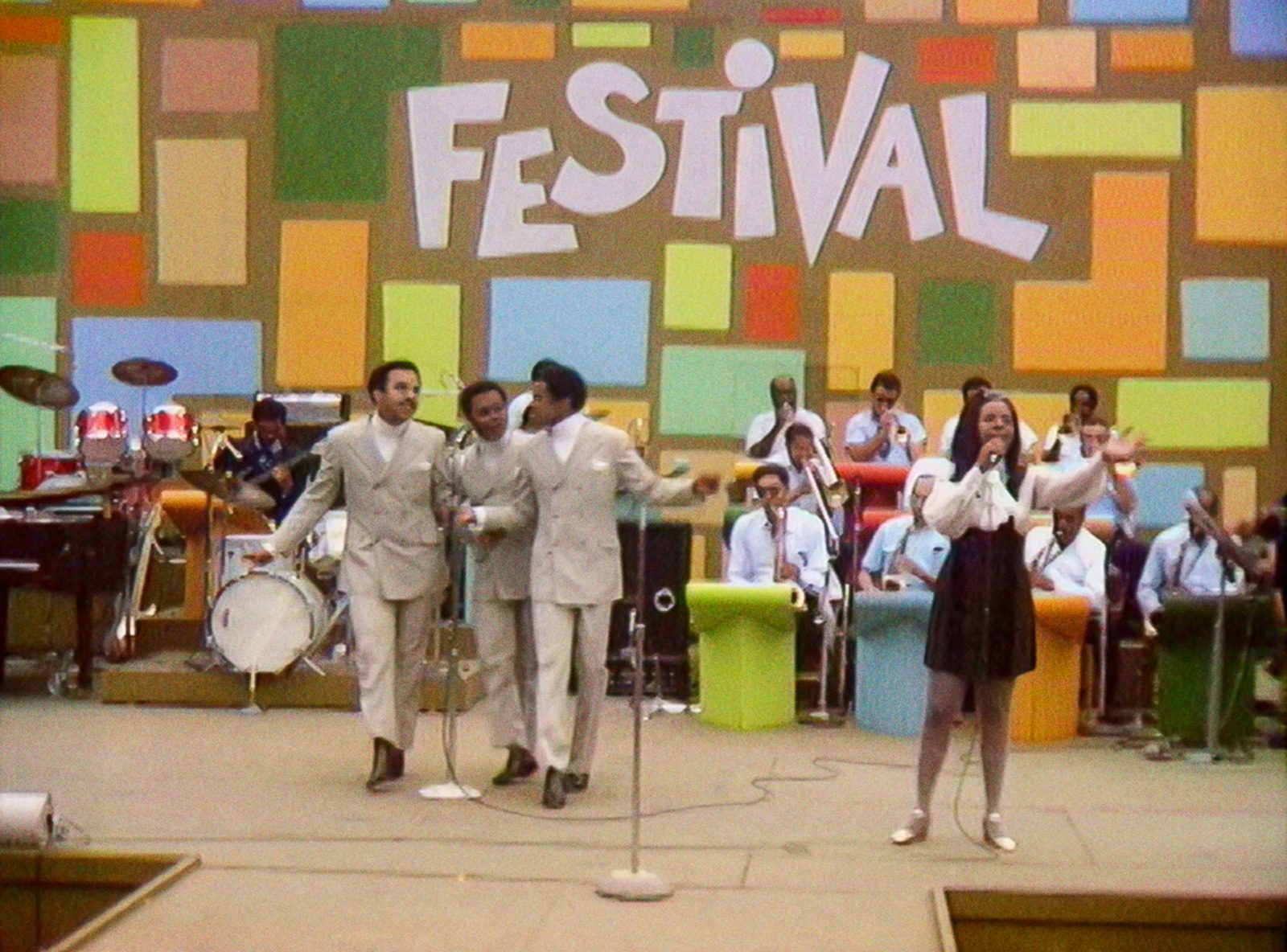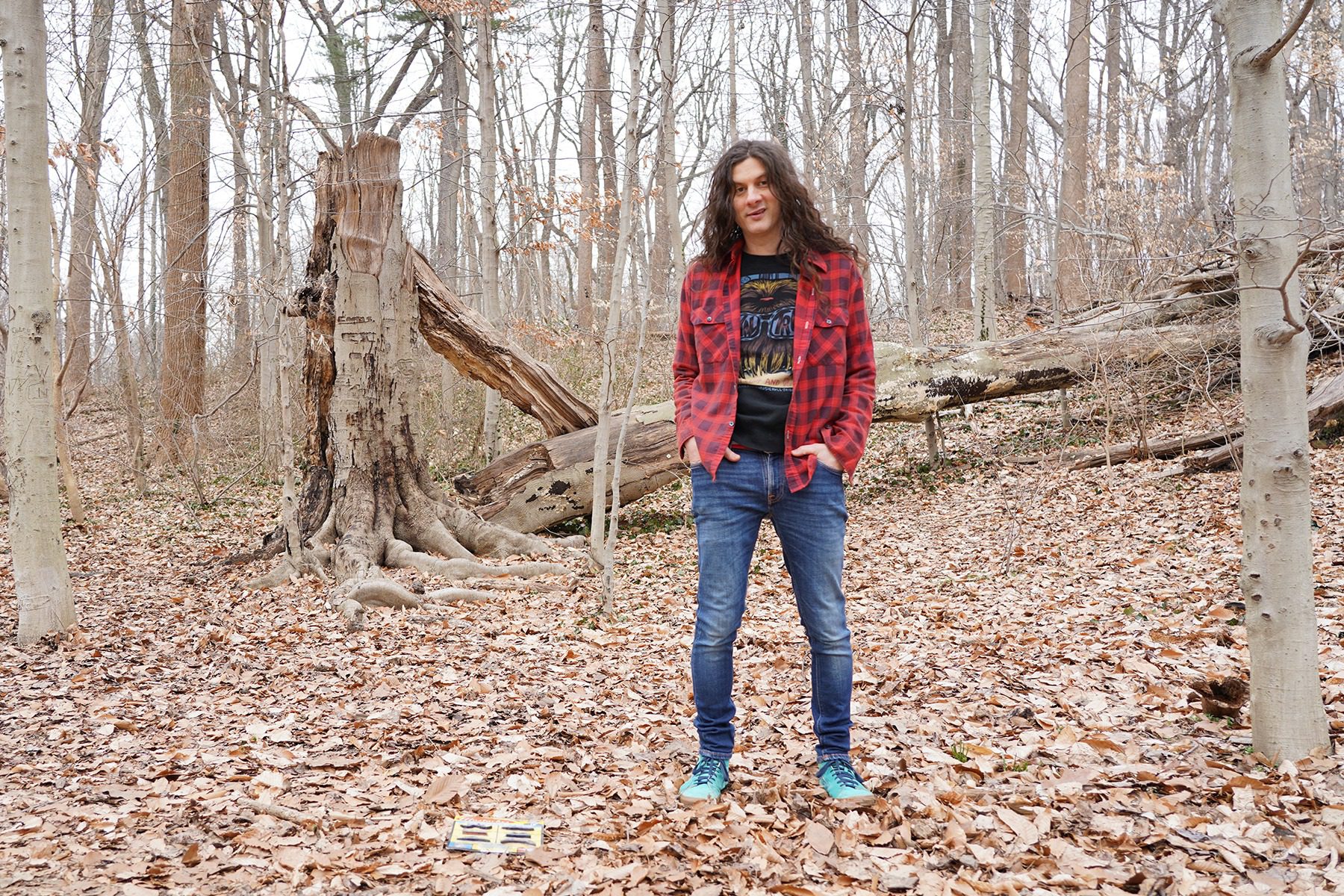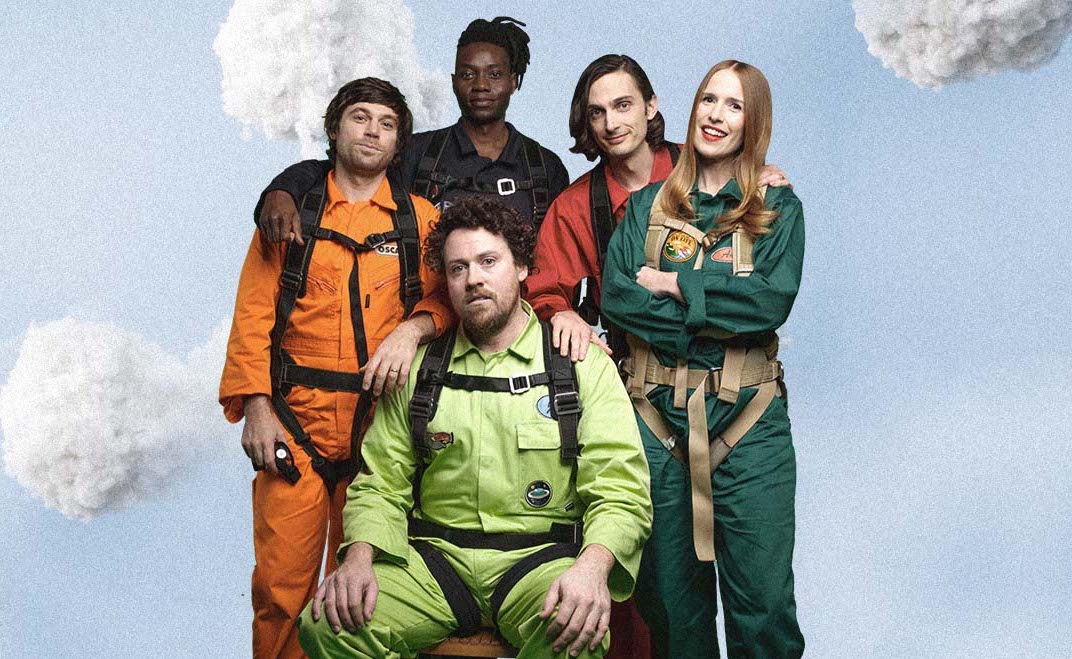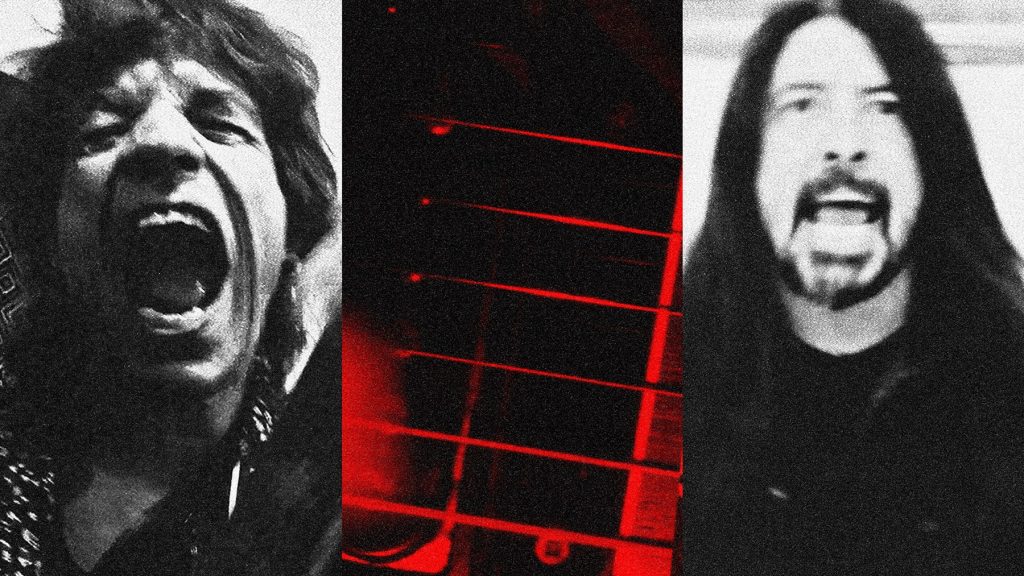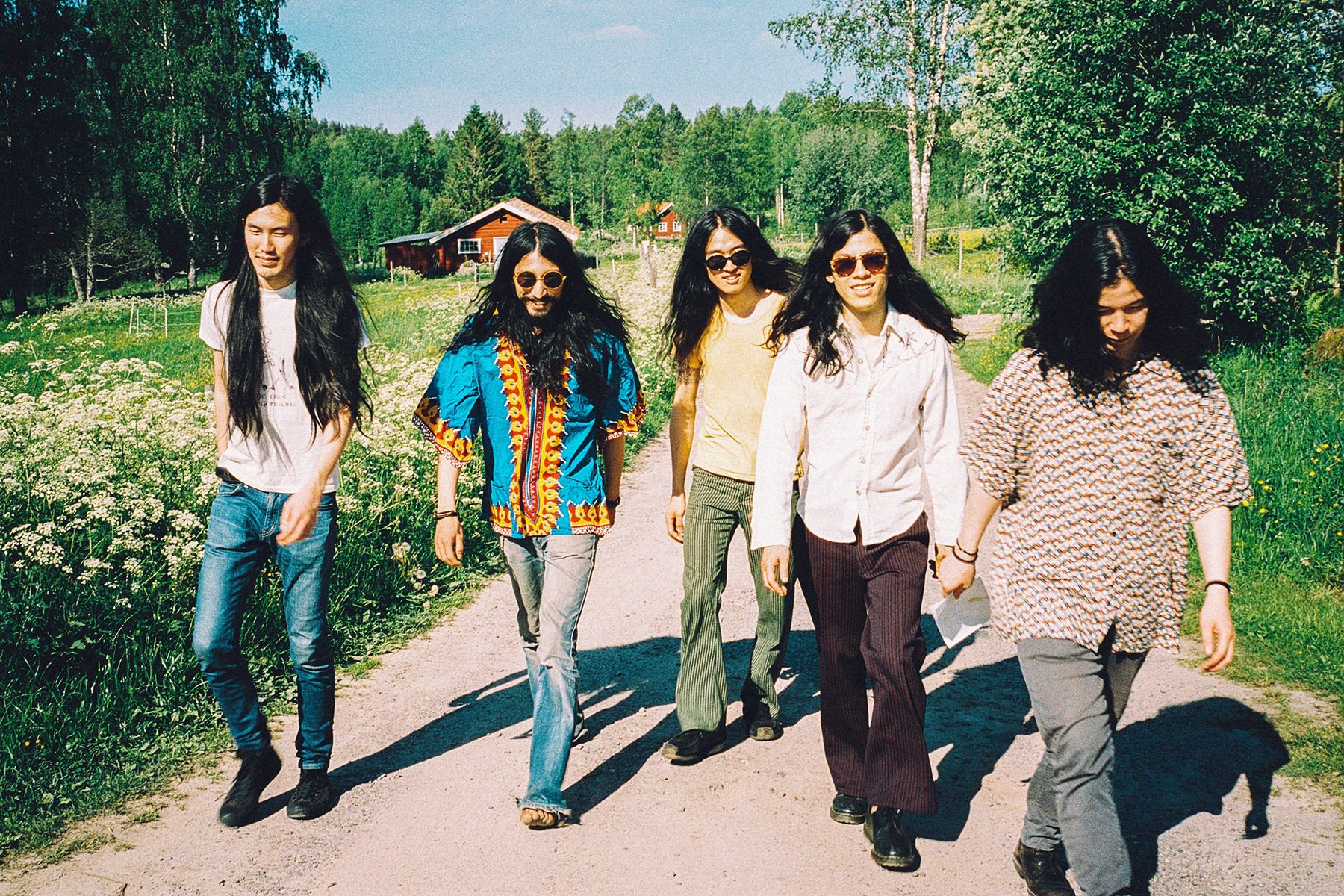
‘Imaginary Playgrounds’: Kikagaku Moyo’s Psych-Rock Odyssey
Kikagaku Moyo literally speak their own language.
The group’s lyrics consist entirely of invented syllables — phonetic sounds that complement their intricate looping riffs. But singing in tongues hasn’t stopped this Japanese quintet from connecting with audiences around the world. Since getting together in 2012, the band has gone from playing small bars to amassing more than 200,000 monthly listeners on Spotify, selling out major venues, and becoming a fixture on the jam-band circuit. Now, they’re planning to go on “indefinite hiatus” following a final album Kumoyo Island, out May 6, and an international farewell tour.
Two of the band’s five members — drummer Go Kurosawa and multi-instrumentalist Tomo Katsurada — spoke with IndieLand about their approximately decade-long run and the decision to call it quits.
“It’s amazing that the music we play echoed,” Kurosawa explains.
Indecipherable lyrics are just one of many things that makes Kikagaku Moyo — which translates to “geometric patterns” — unique. They play an expansive take on psychedelic rock that ranges from metallic to meditative. Part of what makes their sound unique is the fact that the band formed in Tokyo, more than 5,000 miles from psychedelia’s Bay Area birthplace.
blogherads.adq.push(function () {
blogherads
.defineSlot( ‘medrec’, ‘gpt-dsk-tab-article-inbody1-uid0’ )
.setTargeting( ‘pos’, [“mid-article”,”mid”,”in-article1″,”mid-article1″] )
.setSubAdUnitPath(“music//article//inbody1”)
.addSize([[300,250],[620,350],[2,2],[3,3],[2,4],[4,2],[640,250]])
;
});
“Japanese psychedelic bands kind of imagined what is psychedelic culture not knowing and not really experiencing exactly what happened in San Francisco, for example,” Kurosawa says, “but kind of imagining … and then trying to create our original.”
Indeed, growing up, Kurosawa thought jam-band godfathers the Grateful Dead were a fashion label when he first saw their famed skull-and-rose merch in the vintage boutiques of Harajuku. And rather than the classics of the Sixties, Kurosawa cites krautrock and more obscure crate-digging finds as key influences.
“Psychedelic rock [in the United States] originated and it has lots of background like roots, like country music, blues music, lots of influence,” Kurosawa says. “We didn’t have the same context.”
Japan has developed its own small psychedelic-rock scene. The genre’s late-Sixties emergence in the U.S. came just as Western rock exploded in popularity among Japanese youth. Early Japanese psych acts like the Flower Travellin’ Band sang in English and covered popular songs from abroad. Later groups — most notably the the long-running collective Acid Mothers Temple — took a more experimental approach and cultivated an underground fan base.
Kurosawa attributes the growth of psych rock in the country to a backlash against Japan’s “strong society.”
“You’re part of one big community as a Japanese — an island, like, limited space,” says Kurosawa. “Because the social order is so strong, it’s like, ‘How can I escape from reality?’”
Katsurada, who has attended many Acid Mothers Temple shows, said that Kikagaku Moyo would be “really honored” if people think they’ve earned a place in that “Japanese psychedelic history.”
Here in the U.S., Kurosawa and Katsurada serve as the band’s de facto spokespeople due to their comfort with English. During college, they both spent some time in the States where they were entranced by the energy at DIY house shows. The language barrier is actually what inspired Kikagaku Moyo’s vocals. It’s an effort to give other audiences the experience they had coming to psychedelia from afar.
“We grew up listening to Western music and never understood what the lyrics meant, but we could get into it. So, I thought that should happen in vice versa,” Kurosawa says. “American people hear English songs all over, but I wanted to give, like — oh, maybe you don’t need to understand. Maybe the sound itself can kind of echo because it’s universal. … I really dig that.”
blogherads.adq.push(function () {
blogherads
.defineSlot( ‘medrec’, ‘gpt-dsk-tab-article-inbody2-uid1’ )
.setTargeting( ‘pos’, [“mid-article2″,”mid”,”in-article2″,”mid-article”] )
.setSubAdUnitPath(“music//article//inbody2”)
.addSize([[300,250],[300,251],[620,350],[2,4],[4,2],[3,3],[2,2]])
.setLazyLoadMultiplier(2)
;
});
As they prepare for one last international tour, Kurosawa feels confident they achieved that goal.
“We wanted to try out if we could actually make people happy … who don’t understand what we were saying,” Kurosawa says. “We went all over the world and then we felt like, this is kind of transcending. It is possible. We can connect with American audiences. We can connect to the Chinese audience. We can connect with the Mexican audience.”
There’s a similar idea behind Guruguru Brain, the label Kurosawa founded with Katsurada in 2014, which has released records by an eclectic roster of artists from all across Asia. For Kurosawa, putting out diverse sounds from, among other places, Taiwan, Indonesia, Pakistan, and Korea is “important” because it allows audiences to more deeply find commonalities and “connect to understanding of deep things.”
“When I listen to some music from another culture or other place, I want to know more about what’s going on,” Kurosawa explains. “When you feel the similarity, ‘Oh, I can relate to this song from the other side of the world,’ that feeling of, ‘I might be able to become friends with them just listening to the song’ … I wanted to make people experience that.”
Reaching for transcendent, universal musical planes is also a goal of Kikagaku Moyo’s extended live shows. Onstage, Kurosawa said the band is focused on trying to “connect with people.” That meant the pandemic was a major obstacle for the group. It took them off the road for a year and a half — by far their longest stretch without performing live since they came together about a decade ago. Kikagaku Moyo returned to the stage in the second half of last year with a tour across Europe and the Western U.S.
The five bandmates used the time off to record Kumoyo Island back home in Japan. Kikagaku Moyo’s process for this latest record was different since they usually work out material live before heading to the studio. Kurosawa says they tried to imagine crowd reactions and that the end result was “kind of like a home-recording vibe.”
“We became kind of freed up,” Kurosawa says with a smile.
blogherads.adq.push(function () {
blogherads
.defineSlot( ‘medrec’, ‘gpt-dsk-tab-inbodyX-uid2’ )
.setTargeting( ‘pos’, [“mid”,”mid-articleX”,”in-articleX”,”mid-article”] )
.setSubAdUnitPath(“music//article//inbodyX”)
.addSize([[300,250],[300,251],[3,3],[620,350],[2,2]])
.setLazyLoadMultiplier(2)
;
});
Katsurada says the time the bandmates spent writing pieces of the album in front of an imaginary audience left him feeling like the end result was the group “jamming together in our mind trip.”
For their prior two albums, Kikagaku Moyo worked with collaborators; Portuguese jazzman Bruno Pernadas produced the band’s 2018 release Masana Temples and they teamed up with singer-songwriter Ryley Walker on a live EP, Deep Fried Grandeur, last year. But the band stood alone for their latest album.
“Because the social order [in Japan] is so strong, it’s like, ‘How can I escape from reality?’” —drummer Go Kurosawa
While the lineup was a return to their roots, Kikagaku Moyo’s sound has clearly evolved. Kumoyo Island includes traces of the funk the band learned on their sojourn to Lisbon, particularly with hints of horns and touches of bells and melodic percussion from the multi-instrumentalist Katsurada. For the new record, they leaned into their atmospheric flower-children tendencies and away from the harder edge showcased in their live shows and EPs. The guitars of Katsurada and Daoud Popal are bathed in a bright sheen reminiscent of Nineties alterna-fuzz.
Their quarantine period was the first time the members of Kikagaku Moyo were all living back in Japan together since their earliest days in a Tokyo share house. That experience helped them decide that this would be their “last year as Kikagaku Moyo.”
“One of the big reasons we decided to go on the indefinite hiatus is we cannot focus 100 percent on the band,” Katsurada explains. “We started as a friend group and we put all our energy to the one project. We spent all our energy in our twenties on one project. Everybody was, like, full-on 100 percent devotion.”
Going back to those roots helped them realize it might be difficult to sustain what Katsurada describes as “that pureness or like that energy” going forward.
“I thought, ‘That’s not going to be Kikagku Moyo,’” Katsurada says.
For Kikagaku Moyo, lockdowns clarified their need to move on by making it more difficult to play together than it was in the past. Some of the band members have begun other projects including Guruguru Brain, which Katsurada and Kurosawa run from their adopted home base in Amsterdam. The pair says the label also has big plans this year including new releases from Minami Deutsch, the Japanese “space rock power trio” Dhidalah, and what they describe as a “modern Singaporean funk” compilation. And owning their own label also helped Kikagaku Moyo wind down on their own terms.
“Its going to be a — how do you say? — the beautiful ending of the project of Kikagaku Moyo,” Katsurada says. “We run this record label by ourself. … We made this situation, to able to make this happen.”
blogherads.adq.push(function () {
blogherads
.defineSlot( ‘medrec’, ‘gpt-dsk-tab-inbodyX-uid3’ )
.setTargeting( ‘pos’, [“mid”,”mid-articleX”,”in-articleX”,”mid-article”] )
.setSubAdUnitPath(“music//article//inbodyX”)
.addSize([[300,250],[300,251],[3,3],[620,350],[2,2]])
.setLazyLoadMultiplier(2)
;
});
The group first formed in the streets around the Tokyo’s jam-packed Shinjuku ward. They played some of their early gigs outside of the Takadanobaba and Koenji train stations. Kurosawa said this was an effort to escape the “pay to play” scene at many Japanese venues where bands are expected to sell a certain number of tickets themselves or cover fees for stage time.
They also performed in front of Yoyogi Park, a famed center for cosplayers who display Japanese styles from rockabilly to loligoth. Kikagaku Moyo’s studious dedication to psychedelic music is almost a musical version of these otaku subcultures, where fans become completely obsessed with a manga, aesthetic, or moment in history.
“It’s totally otaku culture,” Kurosawa said with a laugh. “But not nerdy — it’s, ‘How can we, like, have really good jams?’”
Kikagaku Moyo’s devotion to psychedelia includes the style as well as the sound. Their Sixties-inspired fashion led GQ to dub them “the best-dressed band of the decade” in 2018. Indeed, the fashion world has taken notice of the group with their music soundtracking runway shows in Paris and a recent campaign for Gucci.
But colorful clothes aren’t the only thing fans of classic rock will find familiar in Kikagaku Moyo’s hours-long live shows. Their gigs feature smooth chemistry and elaborate jams on guitar and a sitar wielded by Kurosawa’s brother, Ryu. In concert the band also leans into its harder edge, with their guitarists trading roaring riffs that bring the crowd into a zone somewhere between the Summer of Love and a modern mosh pit.
Despite their swaggering solos and the fact that two of its members — Ryu, who traveled to India to study his instrument, and Katsurada, who spent a decade learning cello as a child — are classically trained, Kurosawa laughs off the idea that Kikagaku Moyo are virtuosos. He’s been playing drums for just about a decade and Katsurada has only had about a year of guitar lessons. According to Kurosawa, the band’s early jam sessions involved the five figuring out how to play while finding their sound. It’s an experience that became an ethos.
“What we’re doing is not that complicated. We just like got together, just tried to figure it out. … None of us really played in a band before,” Kurosawa says. “I want to inspire people who never played in a band, but kind of secretly have a guitar in their home.”
The devotion to jamming in front of fans is part of why Kikagaku Moyo are embarking on one last tour. Their last performance in North America is scheduled to take place at New York’s Brooklyn Steel on Oct. 6, and the pair say the final show will take place in Tokyo. For Kurosawa, the farewell tour and album are one last geometric pattern, coming full circle.
“We’re from an island and I realized all the past albums were places that we imagined like Masana Temples, a forest garden, all these places — kind of imaginary playgrounds that we created through music,” Kurosawa explains. “And then ‘Kumoyo’ is the last bit of our band name, Kikagaku Moyo, and it’s an island where we came from. So, it’s kind of closing the loop.”
blogherads.adq.push(function () {
blogherads
.defineSlot( ‘medrec’, ‘gpt-dsk-tab-inbodyX-uid4’ )
.setTargeting( ‘pos’, [“mid”,”mid-articleX”,”in-articleX”,”mid-article”] )
.setSubAdUnitPath(“music//article//inbodyX”)
.addSize([[300,250],[300,251],[3,3],[620,350],[2,2]])
.setLazyLoadMultiplier(2)
;
});
